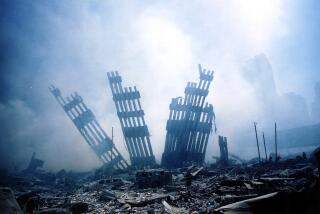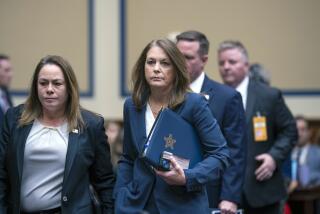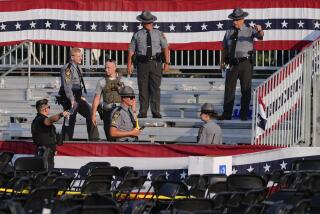40 minutes to capture or kill: Timeline, history of Osama bin Laden raid
Reporting from Washington — After landing by helicopter at the Pakistani compound housing Osama bin Laden early Monday, local time, the U.S. special operations team tasked with capturing or killing the Al Qaeda leader found itself in an almost continuous gun battle.
For the next 40 minutes, the team cleared the two buildings within the fortified compound in Abbottabad, north of Islamabad, trying to reach Bin Laden and his family, who lived on the second and third floors of the largest structure, senior Defense Department and intelligence officials said Monday.
“Throughout most of the 40 minutes, they were engaged in a firefight,” said a senior Pentagon official, who characterized the operation as intense but deliberate.
Bin Laden “resisted” and was killed by U.S. gunfire in the larger building toward the end of the operation. He fired on the assault team, a U.S. official said, and may have tried to use his wife as a shield. Other officials disputed that Bin Laden fired a weapon. A woman also was killed, but it was not Bin Laden’s wife, officials said.
After the firefight, the special-operations force quickly gathered papers — valuable intelligence on Al Qaeda, officials said — and other materials in the two buildings and clambered back on helicopters, taking Bin Laden’s corpse with them.
Before departing, the U.S. team blew up one of the helicopters, a Blackhawk, which had experienced mechanical problems, officials said.
No detainees were taken, and the women and children who survived the attack were left at the compound, Pentagon officials said.
“This wasn’t an execution,” one U.S. official later said. “The assessment going into it was that it’s highly unlikely that’s he’s going to be taken alive, but if he decided to lay down his arms, he would have been taken captive.”
Bin Laden’s body was taken to the aircraft carrier Carl Vinson in the northern part of the Arabian Sea and buried at sea Monday at around 1 a.m. EDT.
Pentagon officials said the decision to bury Bin Laden at sea was made because no country was willing to take the body for burial. But it also seems clear that the United States wanted to avoid him being buried on land for fear that the location could become a shrine for Bin Laden’s supporters.
The funeral was conducted using what a Pentagon official said were “traditional procedures for Islamic burials.”
The body was washed and placed in a white sheet on a flat board as a U.S. military chaplain read remarks that were translated into Arabic. Then the board was lifted up, the official said, and the “deceased body eased into the sea.” The funeral was conducted on the ship’s hangar deck, not the flight deck, which is at the waterline.
The assault was quick, brutal, risk-filled — and ultimately a massive success, the product of months of careful planning and years of intelligence gathering.
Years of gathering intelligence
Before learning of the compound in Abbottabad last August, the U.S. had had little hard information about Bin Laden’s whereabouts for many years, senior intelligence officials said Monday.
But after learning the identity of one of Bin Laden’s couriers, they tracked him to the facility, which immediately raised suspicions because of its elaborate security and relative luxury compared with the surrounding neighborhood, the officials said.
Key information that enabled the Central Intelligence Agency to eventually identify the courier came from detainees held by the U.S., according to senior intelligence officials, and crucial information came from interrogations years ago of 9/11 mastermind Khalid Shaikh Mohammed, officials said. Mohammed had been subjected to waterboarding and other brutal interrogation methods.
“We were able to get pieces of information from detainees,” the official said. “That took years, and these guys don’t give it up all willingly.”
The information enabled intelligence agencies to develop “a composite” of Bin Laden’s courier network, which he used to smuggle out audiotapes and to communicate with underlings.
It took months to build a picture of who was living in the compound, but eventually the CIA concluded that one of the families matched intelligence suggesting that Bin Laden was living with several wives and children in Pakistan.
“There wasn’t perfect visibility on everything inside the compound, but we did have a very good idea,” as surveillance continued, of the number of people living there, including how many women and children were in one of the families, said one of the intelligence officials. The number squared with the number believed to be living with Bin Laden.
It wasn’t until early 2011 that the intelligence agencies became more certain that Bin Laden might be hiding there, one of the senior intelligence officials said,
“Earlier this year, our confidence level grew much higher,” the official said.
‘Several possible courses of action’
As that confidence grew, President Obama in March ordered his national security team to develop “several possible courses of action” for invading the Abbottabad site, according to senior administration officials.
The team brought several options to the president for review. Those options were “refined” over the course of the next several weeks, the official said.
All in all, the president convened at least nine meetings with his national security team, whose members also met among themselves at regular intervals.
The president did not authorize the bombing of the compound, the official said, preferring instead an extraction operation that called for Bin Laden either to be captured or killed by a U.S. team on the ground — although some officials believed his capture to be an unlikely outcome.
Officials denied that they had decided ahead of time to kill Bin Laden, rather than attempt to take him prisoner. “The purpose of the operation was to kill or capture Bin Laden,” a senior Pentagon official said Monday. “There were certainly capture contingencies.”
Though Pakistan’s government was not told that the U.S. suspected Bin Laden was at the compound, it did provide information that helped focus efforts on the Abbottabad fortress, one of the senior intelligence officials said.
“There was body of intelligence brought” to Obama, one of the Pentagon officials said, “but in the weeks and months beforehand, his personal attention pushed the case to a new level.”
On Friday, before traveling to Alabama to survey storm damage, the president gave the go-ahead for the team to go in. The original plan was for it to go in Saturday, but due to weather, they changed it to Sunday.
Had the operation gone on Saturday as planned, it would have coincided closely with a North Atlantic Treaty Organization strike on a house in Tripoli where Libyan leader Moammar Kadafi, another longtime U.S. foe, was believed to have been visiting. That strike killed Kadafi’s son.
Saturday evening, the president offered light remarks at the White House correspondents dinner at a hotel in Washington, joking about his birth certificate and Donald Trump, but he had spent much of the day being briefed on the operation. And his national security staff was working furiously back at the White House.
At one point, the president left the dais at the dinner, but he soon returned.
On Sunday, Obama monitored the operation in the White House situation room, along with Tom Donilon, his national security advisor.
John Brennan, the administration’s counter-terrorism adviser, said it was “probably one of the most anxiety-filled periods of times in the lives of the people assembled here yesterday. Minutes passed like days.”
Other officials present in the room included Vice President Joe Biden, Secretary of State Hillary Clinton, Defense Secretary Robert Gates, Joint Chiefs Chairman Adm. Mike Mullen and James Clapper, the director of national intelligence.
At 2 p.m. Sunday EDT, Obama met with his national security team to review final preparations on the assault.
At 3:50 p.m., he learned that Bin Laden had been “tentatively identified.” A little more than three hours later, the president was told, after the operation, that there was a “high probability” that it had been the Al Qaeda leader who had been killed in the operation.
DNA testing would later confirm Bin Laden’s identity. Seeking to dispel questions about whether Bin Laden was actually killed, a senior intelligence official said Monday that the CIA and other agencies had conducted “initial DNA analysis,” comparing a sample taken from the body with DNA samples from several Bin Laden family members.
The results matched, leading the official to say that there was “virtually 100%” certainty that the body was that of Bin Laden.
In addition to DNA samples, a woman believed to be one of his wives identified Bin Laden by name during the operation, the intelligence official said. CIA specialists also compared photographs of the body with previous shots of Bin Laden, the official said.
Informing top lawmakers of Bin Laden’s death
Soon after the operation was completed, the calls to Democratic and Republican leaders on Capitol Hill went out.
Obama personally called House Speaker John Boehner (R-Ohio) and Senate Majority Leader Harry Reid (D-Nev.) to inform them about the operation and Bin Laden’s death.
Reid said Monday that Obama called shortly after 9:30 pm EDT. “The president was very somber,” Reid said.
Vice President Biden called Senate Minority Leader Mitch McConnell (R-Ky.) at 10 p.m. EDT. Senate Majority Whip Dick Durbin (D-Ill.) got a call Sunday night from the vice president, as did House Majority Leader Eric Cantor (R-Va.).
Defense Secretary Robert Gates called Sen. John McCain (R-Ariz.), the ranking member of the Senate Armed Services Committee.
Reid indicated he had been briefed regularly by Leon Panetta, director of the CIA. The two had held one-on-one briefings, often in rooms in the Capitol, for several months. The briefings were broadly focused but also contained information about the compound being targeted in Pakistan.
“I’ve been following this with director Panetta for some time now,” Reid said. When the president called Sunday night, Reid said, “I had in my mind’s eye” the facility.
Rep. Mike Rogers (R-Mich.), chairman of the House Intelligence Committee, said Monday he and other committee members were first briefed about the compound in January.
Then, intelligence officials believed there was not enough information to confirm it was Bin Laden’s residence, Rogers said.
“They believed that someone important was using this facility … but just wasn’t sure what the target was,” he said. Rogers said intelligence that helped lead to Bin Laden’s death first surfaced four years ago but declined to be specific.
Senate Intelligence Committee Chairwoman Dianne Feinstein (D-Calif.) was told the news by Panetta on Sunday but did not wait for the president’s speech to share the development. She blurted it out at a memorial service in California.
Meanwhile, Rep. Jean Schmidt (R-Ohio), a member of the House Foreign Affairs Committee, said she found out news of Bin Laden’s death “like everybody else.”
“I was watching ‘Celebrity Apprentice’ when they broke in,” she said. “I felt sorry for the president. Every news station already had that it was Osama Bin Laden. But I wanted to stay up [for his speech] and hear how it happened.”
This article was written by Washington Bureau reporters David S. Cloud, Ken Dilanian, Christi Parsons, Lisa Mascaro and James Oliphant. Kathleen Hennessey, Peter Nicholas, and Melanie Mason of the Washington Bureau also contributed to this report.
More to Read
Sign up for Essential California
The most important California stories and recommendations in your inbox every morning.
You may occasionally receive promotional content from the Los Angeles Times.










